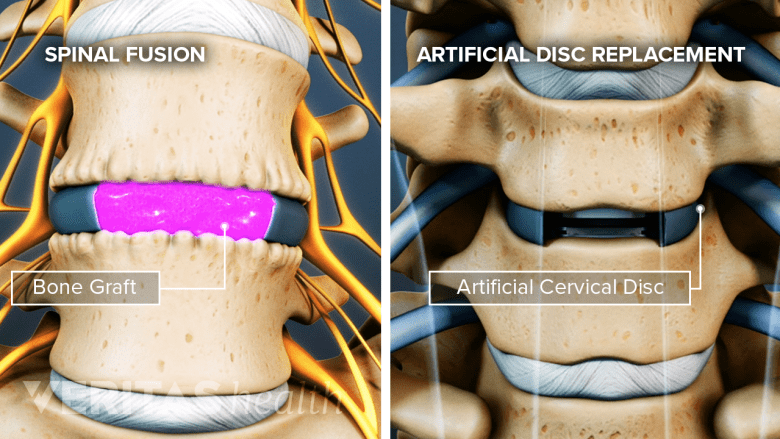While neither of these procedures is perfect, each approach has relative potential benefits and risks.
In This Article:
- Two-Level Cervical Disc Replacement
- Comparison of 2-Level Cervical Artificial Disc vs. 2 Level ACDF
- Cervical Disc Replacement Surgery Video
Potential advantages of cervical artificial disc replacement
Cervical disc replacement allows more motion compared to fusion surgery.
- Allowing a more normal range of motion, which in turn is thought to reduce the incidence of adjacent level degenerative changes (and potentially the need for more surgery at those levels). More study with longer follow-up needs to be done on this topic.
- Decreased need for revision surgery for pseudarthrosis (failure of fusion) or problems related to fusion hardware (plates and screws).
- Decreased risks related to plating at the front of the neck (such as difficulty swallowing).
- No risk associated with bone harvesting, such as the potential for local pain at the patient's hip, where the bone is taken, or risks associated with using cadaver bone for the fusion.
Potential benefits of Disc Replacement vs 2-level ACDF

Placement of an artificial disc and fusion of the spinal segment are 2 major cervical spinal surgeries.
Spinal fusions have been performed in the United States since as early as the 1950s, while disc replacement technologies have only been around since they were first approved by the FDA in the mid-2000s. Two-level cervical artificial discs have been approved for use for an even shorter period of time, and presently published data are only available for 2-year follow-up, although longer-term results are being tabulated. As such, longer-term risks and potential complications are less well known relative to ACDF. For some patients and surgeons, the most substantial potential future risk is if the disc implant would need to be removed at some point in the future. Since many people who are candidates for this procedure are relatively young, this is a significant consideration.
A second potential risk of cervical disc replacement is that the implant used may at some point suffer a mechanical failure or breakage; this is a risk for any newer type of implant and is not unique to the disc prosthesis per se.
More data on disc replacement is being generated every year, and longer-term outcomes are being carefully tracked under FDA monitoring, but both patients and physicians must understand that this is a newer surgical option without longer term experience. Reoperation rates after cervical disc replacement are generally less than after fusion surgery. Revision of a failed artificial disc implant to a fusion, although unlikely, is usually possible.
Editor’s Top Picks
- ACDF: Anterior Cervical Discectomy and Fusion
- Cervical Artificial Disc Replacement Technologies
- Cervical Artificial Disc Replacement Surgery
- Potential Complications and Risks of Cervical Disc Replacement Surgery
- Considerations for Cervical Disc Replacement Surgery
- Recovery from Cervical Artificial Disc Replacement Surgery

